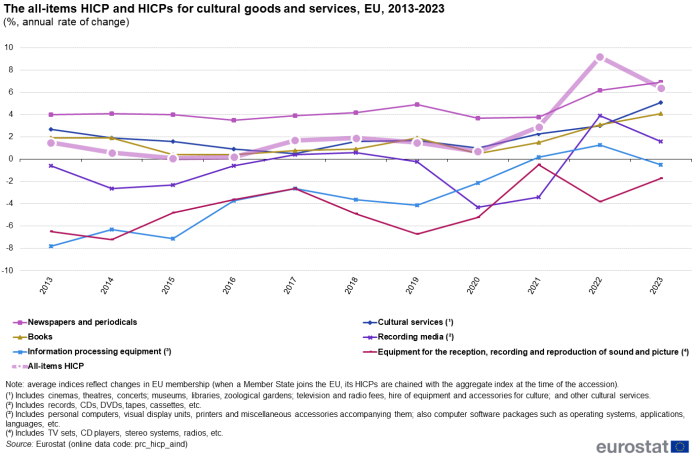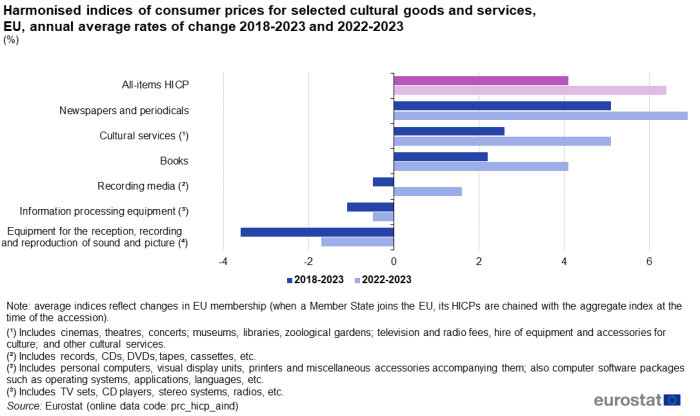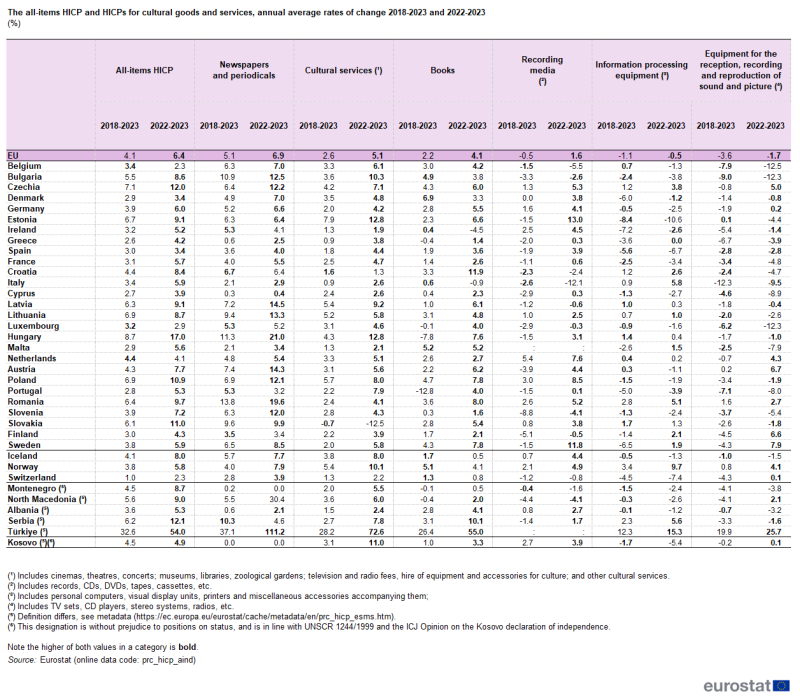Consumer prices of cultural goods and services
Data extracted in January 2024
Planned article update: April 2025
Highlights
In 2023, the harmonised consumer price index showed newspapers and periodicals prices rising in all EU countries compared with 2018.
The all-items HICP and HICPs for cultural goods and services, EU, 2013-2023
This article, part of the "Culture statistics" online publication, provides an overview of how prices of cultural goods and services have changed based on the harmonised index of consumer prices (HICP).
Full article
HICP for cultural goods and services – trends at EU level
In addition to the headline inflation aggerate, the 'all-items HICP', there are around 400 sub-indices for different goods and services. The article focuses on six sub-indices related to culture:
books; newspapers and periodicals; equipment for the reception, recording and reproduction of sound and picture; recording media; information processing equipment and cultural services.
When analysing the HICP sub-indices related to culture, some basic trends can be observed at the EU level between 2013 and 2023:
- prices of newspapers and periodicals rose faster than the other cultural goods tracked by the HICP;
- over the last ten years, prices of books and cultural services rose at a modest pace;
- prices of recording media decreased slightly throughout most of the period; this sub-index recorded an increase only in 2017, 2022 and 2023;
- prices of information processing equipment as well as equipment for the reception, recording and reproduction of sound and picture followed a similar pattern throughout most of the period; with the exception of 2021 and 2022, when the prices of information processing equipment slightly increased.
The details of these trends are shown in Figure 1.

(%, annual rate of change)
Source: Eurostat (prc_hicp_aind)
The annual average rate of change (indicated with darker bars in Figure 2) shows that, between 2018 and 2023, at the EU level, 'newspapers and periodicals' recorded the highest price increase among cultural products. The 'newspapers and periodicals' HICP increased by an average of 5.1 % per year, 1 percentage point higher than the all-items HICP. In other words, the prices of newspapers and periodicals rose faster than the headline inflation. Rates of change for 'cultural services' and 'books' sub-indices were also positive but lower than the all-items HICP. Among the remaining three groups of cultural products which saw decreases, the fall in prices was the most pronounced for the 'equipment for the reception, recording, and reproduction of sound and picture' sub-index. Prices in this category of cultural products declined between 2018 and 2023 at an average annual rate of 3.6 %.
Between 2022 and 2023, prices of 'equipment for the reception, recording, and reproduction of sound and picture' decreased by 1.7 %, while prices of 'information processing equipment' decreased by 0.5 %. Among all remaining culture-related HICPs that increased, only the prices of newspapers and periodicals rose faster than the all-items HICP (see Figure 2).

(%)
Source: Eurostat (prc_hicp_aind)
HICP for cultural goods and services – focus on countries
Data on consumer price development for cultural goods and services are presented in Table 1. It shows the change in the average annual rates of cultural goods and services price indices in EU countries between 2018 and 2023 and between 2022 and 2023. In 2018-2023, the annual average rate of change of all-items HICP in the EU was 4.1 %. Nine EU countries recorded a rate of change of more than 5 % a year in their all items HICP in that period. Between 2022 and 2023, the rate of change of the all-items HICP was 6.4 % in the EU, with four Member States experiencing double-digit inflation rates during this period.
All EU countries saw a rise in newspapers prices over the past five years
In 2018-2023, all the EU countries saw a rise in 'newspapers and periodical' prices. Over that period, the annual average rate of change for this category was higher than for the headline inflation in 20 EU Member States. Between 2022 and 2023 prices of newspapers and periodicals grew faster than the headline inflation in 16 EU countries. During that one-year period, the highest price growth for newspapers and periodicals was recorded in Hungary (21.0 %) and Romania (19.6 %).
Between 2018 and 2023, the annual average rate of change for the prices of 'cultural services' was slower than the overall inflation rate in all EU Member States, except Estonia and Denmark. The fastest growth rates for cultural services prices (over 5 % per year, on average) were recorded in the Baltic Member States and Poland. Slovakia was the only country where the price index of cultural services decreased in 2023 compared with 2018. Between 2022 and 2023, the 'cultural services' sub-index grew faster compared with the all-items HICP in 9 EU Member States.
In 2023, the annual average price index for books was lower in four EU countries compared with 2018. The decline in book prices between these years was most noticeable in Portugal, where the 'Books' sub-index recorded an average decrease of 12.8 % per year. Between 2018 and 2023, average book prices rose faster than the headline inflation rate in only three EU countries – Denmark, Malta and Sweden. From 2022 to 2023, annual average book price index increased faster than the headline inflation rate in only three EU countries – Denmark, Malta and Sweden. From 2022 to 2023, annual average book price index increased faster than the headline inflation in Croatia, Belgium, Sweden, Luxembourg and Spain.
In the five-year period between 2018 and 2023, the sub-index for 'recording media' decreased in 17 EU Member States (no data for Malta). The price index for 'recording media' fell the fastest in Slovenia (-8.8 % per year, on average) and Finland (-5.1 %). However, in 2023, prices for 'recording media' increased in 18 EU Member States compared with the previous year, with the largest increases in Estonia (13.0 %) and Sweden (11.8 %).
The prices of information processing equipment returned to a downward trend
Between 2018 and 2023, the 'information processing equipment' index decreased in 16 EU Member States. The largest annual average decrease in the index was recorded in Estonia (-8.4 % per year), while the largest annual average increase of 'information processing equipment' price index occurred in Romania (2.8 %). From 2022 to 2023, the 'information processing equipment' index decreased in 14 EU Member States, with the largest decreases observed in Estonia (-10.6 %) and Spain (-6.7 %). During the same period, the largest increases in information processing equipment prices were observed in Italy (5.8 %) and Romania (5.1 %).
The index for 'equipment for the reception, recording, and reproduction of sound and picture' saw the most significant decline between 2018 and 2023 in Italy (on average -12.3 % a year). Slight increases in this index were observed in Romania, Austria and Estonia (1.6 %, 0.2 %, and 0.1 % a year on average, respectively). Between 2022 and 2023, the index for this type of equipment decreased in 20 EU countries, with the largest drops recorded in Belgium (-12.5 %), Bulgaria and Luxembourg (-12.3 % in both countries).

(%)
Source: Eurostat (prc_hicp_aind)
Source data for tables and graphs
Data sources and methodology
Eurostat compiles data on the development of prices using harmonised index of consumer prices (HICP).
Eurostat publishes the harmonised index of consumer prices (HICP) which provides a comparable measure of inflation for EU Member States and various products and services. These indices measure changes over time for prices of consumer goods and services bought by households. In other words, they are a set of consumer price indices calculated according to a harmonised approach and a set of definitions as laid down in EU law.
The HICP uses the European classification of individual consumption according to purpose adapted to the needs of the HICP (ECOICOP-HICP). This is the European version of the UN classification of individual consumption according to purpose COICOP. For culture statistics, ECOICOP-HICP covers two main categories: cultural goods and cultural services.
- ECOICOP cultural items include:
- books and newspapers;
- equipment that allows various forms of culture to be consumed (TV and stereo equipment; information and communication technologies);
- recording media on which some cultural products can be delivered (CDs, DVDs or Blu-rays);
- cultural services (cinemas, theatres, concerts; museums, libraries, zoological gardens; television and radio fees, hire of equipment and accessories for culture).
Context
Culture is one of Europe's greatest assets: it is a source of values and identity and creates a sense of belonging. It also contributes to well-being, social cohesion and inclusion. The cultural and creative sectors can trigger economic growth, job creation and international trade.
This is why culture is becoming more important in the EU. In line with Article 167 of the Treaty of Lisbon, the EU 'shall contribute to the flowering of the cultures of the Member States, while respecting their national and regional diversity and at the same time bringing the common heritage to the fore'.
The EU supports these objectives through the Creative Europe programme and a number of policy actions included in the work plan for culture (2023-2026) setting the main priorities for European cooperation in cultural policymaking: empowering the cultural and creative sectors; enhancing cultural participation and the role of culture in society; unleashing the power of culture; and strengthening the cultural dimension of the EU external relations. According to the work plan, implementation should also be supported by optimised use of quality data and statistics.
Direct access to
See also
- Culture statistics - household expenditure on culture
- Culture statistics - use of ICT for cultural purposes
- HICP methodology (background article)
- Culture (all Statistics Explained articles on culture)
- Sport (articles on sport statistics)
Database
- Culture (cult), see:
- Private households expenditure on culture (cult_exp)
- HICP - annual data (average index and rate of change) (prc_hicp_aind)
- HICP - monthly data (index) (prc_hicp_midx)
Dedicated section
Publications
Methodology
Legislation
- European Council work plan for culture (2023-2026)
- European Council work plan for culture (2019-2022)
- European Council work plan for culture (2015-2018)
- Regulation (EU) No 2021/818 of the European Parliament and of the Council of 20 May 2021 establishing the Creative Europe Programme (2021 to 2027) and repealing Regulation (EU) No 1295/2013
- Communication from the Commission to the European Parliament, the Council, the European Economic and Social Committee and the Committee of the Regions on a European agenda for culture in a globalising world (COM(2007) 242)
The requirements and compilation guidelines for the HICP are governed by the regulations and implementing acts available in the dedicated sub-section of the 'HICP' section on the Eurostat website.
External links